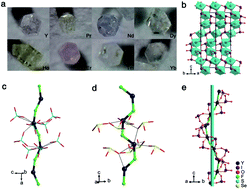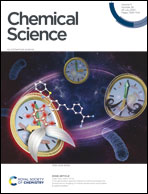Helix-constructed polar rare-earth iodate fluoride as a laser nonlinear optical multifunctional material†
Abstract
The first trivalent rare-earth iodate fluoride nonlinear optical (NLO) crystal, Y(IO3)2F (YIF), was successfully designed and synthesized, featuring polarization-favorable helical chains constructed from trans-YO6F2 polyhedra and IO3 groups. It exhibited a suitable balance of a wide transparency range of 0.26–10.0 μm, high laser damage threshold (LDT) of 39.6 × AgGaS2, and moderate second harmonic generation (SHG) effect of 2 × KDP. A series of doped RE:YIF (RE = Pr, Nd, Dy, Ho, Er, Tm, and Yb) crystals were easily synthesized benefiting from the spring-shaped helix structure, which possess wide absorption and emission peaks as well as long lifetime, especially in the visible and near-infrared regions. Particularly, the remarkable fluorescence properties of Nd and Yb doped YIF crystals are comparable to and even better than those of traditional self-frequency doubling (SFD) crystals such as YAB, YCOB, and GdCOB. Thus, these RE-doped YIF crystals are promising laser SFD crystals. This work also indicated that constructing helical chains should be an effective strategy for the design of inorganic polar materials.



 Please wait while we load your content...
Please wait while we load your content...